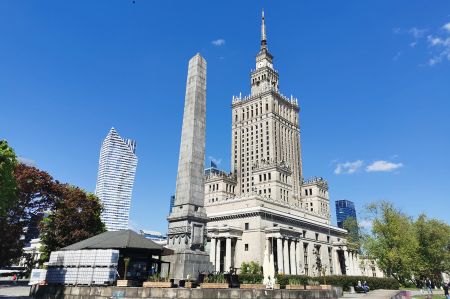Let's go downtown Warsaw – by Public Transport
- Written by Portal Editor
In terms of local public transport, Warsaw not only has a really well-developed network of cycle paths, but also a good bus, tram and underground network.
The 121 km long Warsaw tram network is served by 27 lines alone. Although it is technically partly outdated, it is increasingly being modernized to include electric buses. The bus network in Warsaw even consists of 219 lines and serves a route network with a total length of approx. 2600 km.
A subway has been operating in Warsaw since April 1995, the completion of which has repeatedly been delayed. The line network currently includes two lines with a total length of 38 kilometers and 36 stations. Line M1 runs in a north-south direction and crosses line M2 at the Świętokrzyska underground station, which opened in March 2015 and runs in a west-east direction, crossing under the Vistula. It is extremely positive to note here that a 72-hour ticket for all the means of transport mentioned costs only 36 zlotys, the equivalent of around €8.00.
By metro M1 to the center of Warsaw
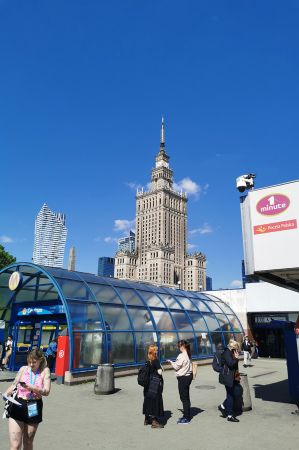 Once there, we also wanted to see the center of Warsaw a little closer, because our last visit had only allowed us time for a typical Polish meal at the Warsaw Royal Castle or in a small restaurant with Polish specialties nearby, which means only a few It was possible to take photos of the castle and Sigismund's Column, which has been the dominant feature of the important Castle Square since 1644. The so-called Kraków Gate and part of the city wall had already been demolished in 1818. However, the street beginning at the Kraków Gate – Krakowskie Przedmieście (Polish: Krakowskie Przedmieście) – kept its name.
Once there, we also wanted to see the center of Warsaw a little closer, because our last visit had only allowed us time for a typical Polish meal at the Warsaw Royal Castle or in a small restaurant with Polish specialties nearby, which means only a few It was possible to take photos of the castle and Sigismund's Column, which has been the dominant feature of the important Castle Square since 1644. The so-called Kraków Gate and part of the city wall had already been demolished in 1818. However, the street beginning at the Kraków Gate – Krakowskie Przedmieście (Polish: Krakowskie Przedmieście) – kept its name.
But let's start our city tour at the selected exit of the M1 in the center at the subway station Centrum, directly opposite the Palace of Culture "Pałac Kultury i Nauki".
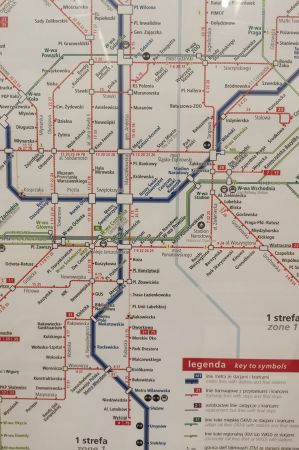 The 44-story Palace of Culture was designed by Russian architect Lev Rudnev. Rudnev was inspired by the Empire State Building in New York and also gathered ideas on a tour of Poland. After visiting cities like Kraków, Zamość and Lublin, he tried to create a synthesis of socialist classicism and traditional Polish architecture. In particular, he adopted the Polish attic from the Renaissance for the lower parts of the building.
The 44-story Palace of Culture was designed by Russian architect Lev Rudnev. Rudnev was inspired by the Empire State Building in New York and also gathered ideas on a tour of Poland. After visiting cities like Kraków, Zamość and Lublin, he tried to create a synthesis of socialist classicism and traditional Polish architecture. In particular, he adopted the Polish attic from the Renaissance for the lower parts of the building.
Poland was controlled by the Soviet Union at the time and because the structure was built as a "gift to the Polish people" or as a "gift from the Soviet nations to the Polish nation" by order of the Soviet leadership under Joseph Stalin, it was originally named after it him and called it Joseph Stalin's Palace of Culture and Science (Pałac Kultury i Nauki imienia Józefa Stalina).
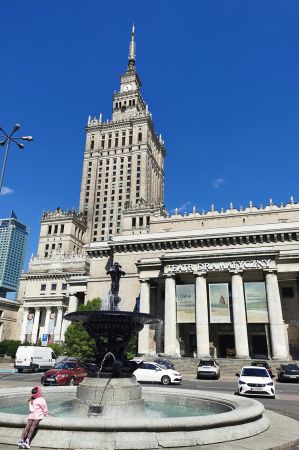 On April 13, 1967, the Rolling Stones, one of the first world-famous rock bands to appear behind the Iron Curtain, were on tour as part of their European tour. The performance in the congress hall in the palace differed from previous Rolling Stones concerts: 3,000 of the 5,000 tickets went free to party officials and their families, so the Rolling Stones played mostly in front of tie-wearing older men instead of screaming teenagers. In front of the palace there were violent clashes between the police and young people who wanted to go to the concert.
On April 13, 1967, the Rolling Stones, one of the first world-famous rock bands to appear behind the Iron Curtain, were on tour as part of their European tour. The performance in the congress hall in the palace differed from previous Rolling Stones concerts: 3,000 of the 5,000 tickets went free to party officials and their families, so the Rolling Stones played mostly in front of tie-wearing older men instead of screaming teenagers. In front of the palace there were violent clashes between the police and young people who wanted to go to the concert.
Initially unpopular to hated as a symbol of totalitarian oppression and mocked by the people of Warsaw, saying that the most beautiful view of Warsaw is from the Palace of Culture, because you don’t have to see it from there and history is popular with many residents and tourists and is one of Warsaw's landmarks. Today the Kulturpalast houses cinemas, four theaters and three museums, an indoor swimming pool and a photography college in its 3,288 rooms; In addition, there are often fashion shows, trade fairs or concerts in the adjacent congress hall. On the 30th floor there is also a viewing platform and a panorama restaurant at a height of 114 metres.
To the Saxon Garden and the Monument to the Unknown Soldier
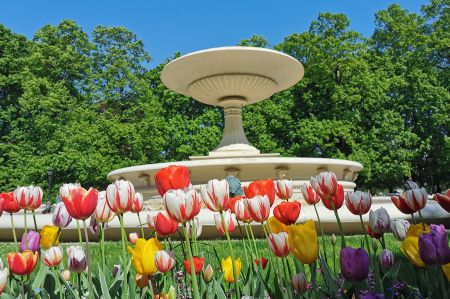 We continue our tour along Ulica Marszałkowska, which is one of the most important north-south traffic arteries in Warsaw. The Marszałkowska extends over a length of 3.8 kilometers through the entire inner city district and runs parallel to the former royal wing at a distance of around 600 meters to the west. It was the city's most important commercial street until the Second World War, in which most of it was destroyed. Through the Saxon Garden, which is a public landscape park with baroque statues, a large fountain, monuments and tree-lined paths, which is heavily frequented in today's wonderful weather, we reach the Monument to the Unknown Soldier and experience a changing of the guard of the soldiers positioned here. A large number of onlookers quickly gathered. The monument to the unknown Polish soldiers who died in World War I is a remnant of the destroyed Saxon Palace.
We continue our tour along Ulica Marszałkowska, which is one of the most important north-south traffic arteries in Warsaw. The Marszałkowska extends over a length of 3.8 kilometers through the entire inner city district and runs parallel to the former royal wing at a distance of around 600 meters to the west. It was the city's most important commercial street until the Second World War, in which most of it was destroyed. Through the Saxon Garden, which is a public landscape park with baroque statues, a large fountain, monuments and tree-lined paths, which is heavily frequented in today's wonderful weather, we reach the Monument to the Unknown Soldier and experience a changing of the guard of the soldiers positioned here. A large number of onlookers quickly gathered. The monument to the unknown Polish soldiers who died in World War I is a remnant of the destroyed Saxon Palace.
Around 1600 the site of the Saxon Palace was that of King Sigismund III. Wasa erected city fortifications of Warsaw. A first castle was built there by Tobias Morsztyn in the early Baroque style. King August II acquired the castle in 1713 and had it redesigned as part of the construction of the Saxon Axis. The expansion was carried out by the Saxon architects Carl Friedrich Pöppelmann and Joachim Daniel von Jauch until 1724. August II also had Saxon Square and the Saxon Garden laid out, the latter in 1713 by Johann Christoph von Naumann.
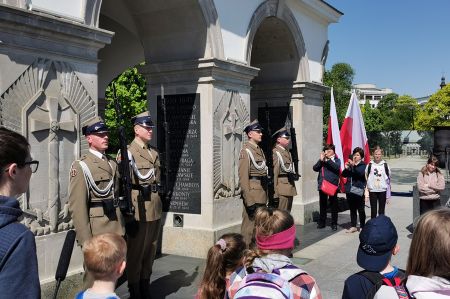 In 1748 two new wings of the castle were built. The Brühlsche Palais north of the Saxon Garden was also built at this time. The palace remained the property of the House of Wettin until 1817, after which it housed the government authorities of Congress Poland until 1831. After the First World War, the General Staff of the Polish Army had its headquarters here, and in particular the Biuro Szyfrów (BS) (English: "cipher office"), which already in 1932 managed to conquer that of the German Reichswehr and later the Wehrmacht with the help of the Rotor -Key machine ENIGMA to decipher encrypted message traffic (see also: Deciphering ENIGMA).
In 1748 two new wings of the castle were built. The Brühlsche Palais north of the Saxon Garden was also built at this time. The palace remained the property of the House of Wettin until 1817, after which it housed the government authorities of Congress Poland until 1831. After the First World War, the General Staff of the Polish Army had its headquarters here, and in particular the Biuro Szyfrów (BS) (English: "cipher office"), which already in 1932 managed to conquer that of the German Reichswehr and later the Wehrmacht with the help of the Rotor -Key machine ENIGMA to decipher encrypted message traffic (see also: Deciphering ENIGMA).
After the Warsaw Uprising in 1944, the palace was systematically destroyed by the German Wehrmacht. Only a fragment of the columned facade has been preserved, in which the Tomb of the Unknown Soldier has been located since 1918.
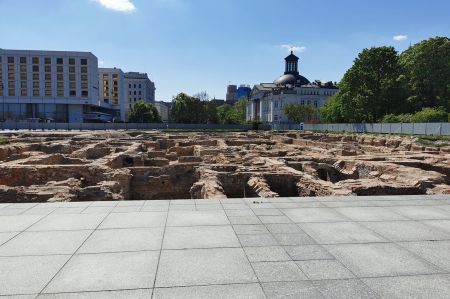 The reconstruction of the building was originally supposed to take place between 2007 and 2009 and cost about 75 million euros. However, the heated debate about alternative uses contributed to the delay in implementation. The planned move of the city administration into the premises of the reconstructed palace was criticized by many as being closed to the public, alternative proposals included a conference centre, museum uses and luxury apartments and restaurants. In 2006 archaeological work was carried out in the excavated cellars of the palace. Around 19,000 historical objects were found, including coins and porcelain. Most foundations should be dismantled and replaced with new ones. In the end, the city administration of Warsaw was supposed to move into the palace. In 2009, the Warsaw magistrate temporarily abandoned the construction plans and postponed them indefinitely.
The reconstruction of the building was originally supposed to take place between 2007 and 2009 and cost about 75 million euros. However, the heated debate about alternative uses contributed to the delay in implementation. The planned move of the city administration into the premises of the reconstructed palace was criticized by many as being closed to the public, alternative proposals included a conference centre, museum uses and luxury apartments and restaurants. In 2006 archaeological work was carried out in the excavated cellars of the palace. Around 19,000 historical objects were found, including coins and porcelain. Most foundations should be dismantled and replaced with new ones. In the end, the city administration of Warsaw was supposed to move into the palace. In 2009, the Warsaw magistrate temporarily abandoned the construction plans and postponed them indefinitely.
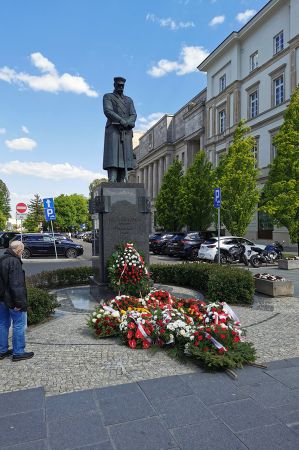 In 2018, the Polish government announced that it would rebuild the Saxon Palace as the future seat of the Senate. A state company was founded in 2021 to implement the project. The costs were estimated at 2.4 billion zlotys, or around 520 million euros at the exchange rate at the time. Critics, meanwhile, spoke of a “luxury mood” on the part of a small group and called the project a facade that would also deprive the Tomb of the Unknown Soldier of its prominent position in the cityscape; because it is the last ruin of the city that bears witness to its destruction in World War II by the German occupying forces.
In 2018, the Polish government announced that it would rebuild the Saxon Palace as the future seat of the Senate. A state company was founded in 2021 to implement the project. The costs were estimated at 2.4 billion zlotys, or around 520 million euros at the exchange rate at the time. Critics, meanwhile, spoke of a “luxury mood” on the part of a small group and called the project a facade that would also deprive the Tomb of the Unknown Soldier of its prominent position in the cityscape; because it is the last ruin of the city that bears witness to its destruction in World War II by the German occupying forces.
To the Royal Route and past the Presidential Palace
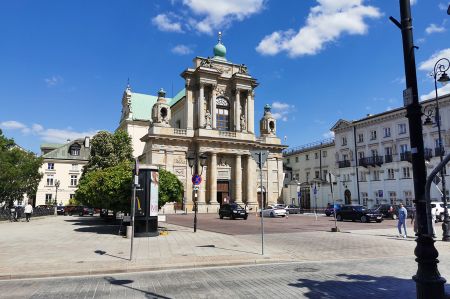 We continued on our way to the Königsweg, which was only one block away. The Royal Route or Royal Tract, Trakt Królewski in Polish, actually begins at Warsaw's Royal Castle, heads south and is one of the longest representative streets in the world. Coming from the Saxon Palace, we came across him just before the Presidential Palace. Originally, it referred to the approximately 4 km long route to the Royal Łazienki Park, later to the Belvedere Palace. Recently, the continuation to the Wilanów Palace, 10 kilometers away, has also been planned by King Jan III. Sobieski included. The historic royal wing consists of several representative streets, the Krakowskie Przedmieście, the Nowy Świat and the Aleje Ujazdowskie (from north to south). It is connected to Wilanów via the later routed streets Ulica Belwederska, Ulica Jana III Sobieskiego and Aleja Wilanowska.
We continued on our way to the Königsweg, which was only one block away. The Royal Route or Royal Tract, Trakt Królewski in Polish, actually begins at Warsaw's Royal Castle, heads south and is one of the longest representative streets in the world. Coming from the Saxon Palace, we came across him just before the Presidential Palace. Originally, it referred to the approximately 4 km long route to the Royal Łazienki Park, later to the Belvedere Palace. Recently, the continuation to the Wilanów Palace, 10 kilometers away, has also been planned by King Jan III. Sobieski included. The historic royal wing consists of several representative streets, the Krakowskie Przedmieście, the Nowy Świat and the Aleje Ujazdowskie (from north to south). It is connected to Wilanów via the later routed streets Ulica Belwederska, Ulica Jana III Sobieskiego and Aleja Wilanowska.
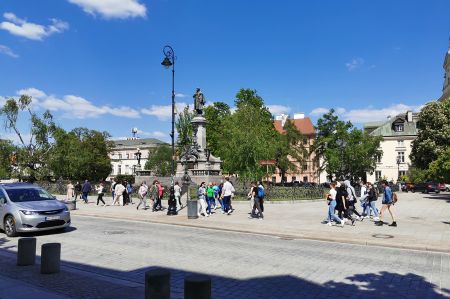 The Royal Route runs approximately parallel to the Vistula at a distance of a few hundred meters to two kilometers and, together with the Saxon Axis running perpendicular to it and Jerozolimskie Avenue, formed the main axis of Warsaw's urban development. Part of it was already built on at the beginning of the city's history and connected the former settlement of Jazdów with the old town.
The Royal Route runs approximately parallel to the Vistula at a distance of a few hundred meters to two kilometers and, together with the Saxon Axis running perpendicular to it and Jerozolimskie Avenue, formed the main axis of Warsaw's urban development. Part of it was already built on at the beginning of the city's history and connected the former settlement of Jazdów with the old town.
The Presidential Palace in Warsaw was built for Hetman Stanisław Koniecpolski in 1643-1645. After the Congress of Vienna, it became the seat of the first Russian governor of Congress Poland, General Józef Zajączek. In the interwar period, the palace was the official seat of the Polish Prime Minister and the government, and the offices of the Council of Ministers were housed in the side wings.
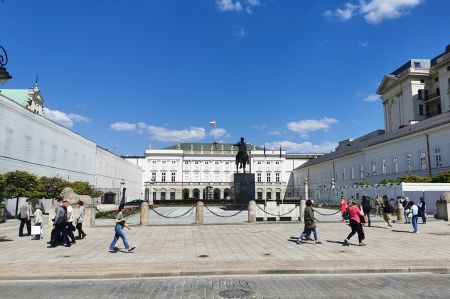 During World War II, the palace served as the "German House", a center for Germans in Warsaw. The palace was only slightly damaged during the Warsaw Uprising, so it was restored by Teodor Bursche, Antoni Jawornicki and Borys Zinserling from 1947 to 1952 and became the seat of the Council of Ministers. After the war, the monument to Józef Antoni Poniatowski by sculptor Bertel Thorvaldsen was placed on Castle Square. In 1955 the Warsaw Pact was signed in the palace and in 1970 the Warsaw Treaty by Józef Cyrankiewicz and Willy Brandt. The round table between the representatives of the communist government and the opposition Solidarność also took place here in early 1989.
During World War II, the palace served as the "German House", a center for Germans in Warsaw. The palace was only slightly damaged during the Warsaw Uprising, so it was restored by Teodor Bursche, Antoni Jawornicki and Borys Zinserling from 1947 to 1952 and became the seat of the Council of Ministers. After the war, the monument to Józef Antoni Poniatowski by sculptor Bertel Thorvaldsen was placed on Castle Square. In 1955 the Warsaw Pact was signed in the palace and in 1970 the Warsaw Treaty by Józef Cyrankiewicz and Willy Brandt. The round table between the representatives of the communist government and the opposition Solidarność also took place here in early 1989.
Since 1995 the palace has been the seat of the Polish President. So far, Lech Wałęsa, Aleksander Kwaśniewski, Lech Kaczyński and Andrzej Duda have resided here.
We continue to follow the royal road to the old town, but more on that later.
Please also read:
Akseki - Silk Road invites you to go hiking
Renewed drama in Turkey: Children-Marriage ends fatally
-
 Hiking the City of Warsaw
Hiking the City of Warsaw
Hiking the City of Warsaw
Hiking the City of Warsaw
-
 Hiking the City of Warsaw
Hiking the City of Warsaw
Hiking the City of Warsaw
Hiking the City of Warsaw
-
 Hiking the City of Warsaw
Hiking the City of Warsaw
Hiking the City of Warsaw
Hiking the City of Warsaw
-
 Hiking the City of Warsaw
Hiking the City of Warsaw
Hiking the City of Warsaw
Hiking the City of Warsaw
-
 Hiking the City of Warsaw
Hiking the City of Warsaw
Hiking the City of Warsaw
Hiking the City of Warsaw
-
 Hiking the City of Warsaw
Hiking the City of Warsaw
Hiking the City of Warsaw
Hiking the City of Warsaw
-
 Hiking the City of Warsaw
Hiking the City of Warsaw
Hiking the City of Warsaw
Hiking the City of Warsaw
-
 Hiking the City of Warsaw
Hiking the City of Warsaw
Hiking the City of Warsaw
Hiking the City of Warsaw
-
 Hiking the City of Warsaw
Hiking the City of Warsaw
Hiking the City of Warsaw
Hiking the City of Warsaw
-
 Hiking the City of Warsaw
Hiking the City of Warsaw
Hiking the City of Warsaw
Hiking the City of Warsaw
-
 Hiking the City of Warsaw
Hiking the City of Warsaw
Hiking the City of Warsaw
Hiking the City of Warsaw
-
 Hiking the City of Warsaw
Hiking the City of Warsaw
Hiking the City of Warsaw
Hiking the City of Warsaw
-
 Hiking the City of Warsaw
Hiking the City of Warsaw
Hiking the City of Warsaw
Hiking the City of Warsaw
-
 Hiking the City of Warsaw
Hiking the City of Warsaw
Hiking the City of Warsaw
Hiking the City of Warsaw
-
 Hiking the City of Warsaw
Hiking the City of Warsaw
Hiking the City of Warsaw
Hiking the City of Warsaw
https://www.alaturka.info/en/poland/warsaw-warszawa/6091-let-s-go-downtown-warsaw-by-public-transport?tmpl=component&print=1&layout=default#sigProId1affefa07b
